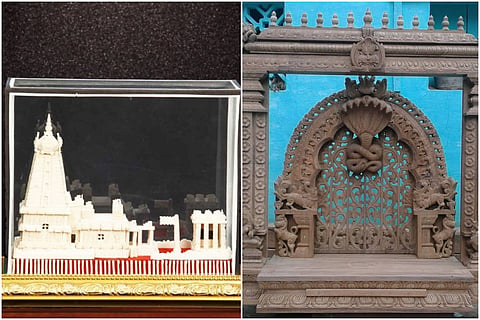

On Tuesday, Tamil Nadu's unique Arumbavur wood carving, native to Arumbavur in Perambalur district and Thanjavur Pith (Netti) works, were awarded the Geographical Indication (GI) tag. The applications for GI was jointly made by the Tamil Nadu Handicrafts Development Corporation Limited (Poompuhar), Arumbavur Wood Carvers' Handicrafts lndustrial Cooperative Society Ltd, and the Arumbavur Temple Car and Woodcarving Artisans Welfare Society. A GI tag marks the geographical origin of a unique handiwork and ensures quality of the product.
The unique aspect of the Arambavur wood carvings is that it is often inspired by architectural details on temple sculptures and carvings. As per the filing with the registry, the ornate Arumbavur wood carvings are primarily made out of the wooden logs of Indian siris (Poo Vaagai, Albizia lebbeck), Mango (Mangifera indica), Lingam tree (Mavilangam), Indian Ash fiee (Othiyan - Odina wodier), Rosewood, Neem tree (Vembu - Azadirachta indica).
Thanjavur Pith work, on the other hand, is made from pith obtained from a particular type of plant - Aeschynomene aspera (netti), a hydrophyte plant - found abundantly in lakes and marshy lands surrounding Thanjavur and Mannargudi region in Tamil Nadu. The pith work models are delicate to handle and are usually preserved inside glass boxes. They resemble ivory and marble handicrafts in looks.
The designs that inspire Arambavur wood carvings lie in temple architecture indigenous to the region. Usually, the statues are crafted at a size ranging from 1 to 12 feet. The art form also draws inspiration from mythology and mythical deities.
Presently, the Arumbavur wood carvings revolve around idols and deities, temple chariots and temple cars, door panels of houses, pooja rooms and temples, decorative figures, pooja mandapam. Whereas Thanjavur pith works are mostly miniature models of temples.
The Arumbavur wood carving artisans have their origins in Madurai. The artisans (predominantly the Boyar community) would travel to the place in which the temple car has to be made, stay in that temple for a period of upto four years and complete the work. Then they would migrate to another place, where a new temple car has to be made. Like this, artisans have led a nomadic life in the past.
However, about 250 years ago, they dropped their roots in Arumbavur, settling in the village and giving the area its unique fame.
(With inputs from IANS)